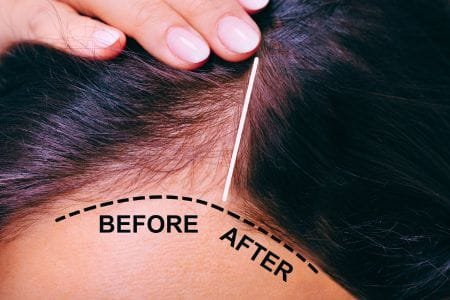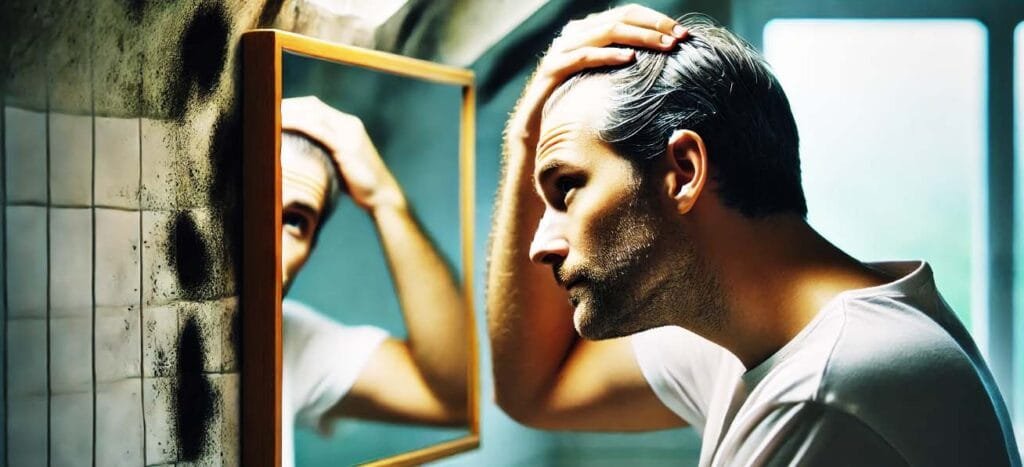Hair loss is a common problem that many of us face. But mold exposure can cause it as well, did you know? Genes, hormones, and lifestyle typically cause hair loss and mold. However, new research suggests mold can also trigger thinning and loss. This guide will explore how hair loss and mold are related. You’ll discover what you need to know and how to address both problems.
What Is Mold, and How Does It Affect Your Health?
Mold is a type of fungus. It can flourish in your house and harm your health. Before understanding how mold relates to hair loss and mold, you must first understand what mold is and how it affects your body.
Mold is a type of fungus. It grows in wet, humid locations. It can be in homes, offices, and other moistened places. However, mold spores are tiny, and you can’t see them with the naked eye. But they can disrupt your health if inhaled or touch your skin.
Common health symptoms associated with mold include:
You may experience respiratory issues such as coughing, sneezing, and wheezing. Your eyes may get itchy and watery. You may get skin rashes. Allergic reactions such as a runny nose or asthma attacks can also happen.
While the symptoms are widely recognized, mold exposure can also cause hair loss and mold. This is not a well-known effect of mold. For some, mold can result in hair loss.
Mold and Its Role in Hair Loss

Mold has seekers in hair care as well as other health problems that many do not think about. In various ways, mold may affect your hair’s health. Here’s how:
1. Immune System Suppression
If you’re exposed to mold for long periods, it can dampen your immune system. Your body begins to go into overdrive in response to the mold spores and other triggers. This leads to chronic inflammation. The inflammation can impact hair follicles by thinning hair or even causing hair loss and mold.
Key Impact: This is the most significant change from an action or event. The key impact is the primary direct, observable outcome. It is the first influence or effect that comes to be. The key impact refers to the central cause or effect that occurs.
The mold can cause autoimmune problems. This can result in hair loss and mold illnesses such as alopecia areata. An impaired immune system can prevent the body from properly nourishing hair follicles. It can also slow down hair growth and weaken hair strands.
2. Toxin Build-Up (Mycotoxins)
The mold produces toxins that can poison you when they get inside your body. These toxins can influence your scalp. They disrupt the normal functioning of your hair follicles. The toxins can inflame the scalp. This can cause hair loss and mold or increased hair shedding.
Key Impact: Everything a business does matters. These impacts can be positive or negative. It is essential to assess the consequences of what you are doing. It helps you improve decision-making. Understanding how your decisions impact your business enables you to iterate and evolve. By knowing the impact, you can make a positive change. This realization is the nucleus of a successful business.
Mycotoxins can influence your scalp nutrient absorption. Poor circulation can result in poor hair health. Toxins can reduce blood flow to the scalp of your body. This reduces the oxygen and nutrients they need to sustain healthy hair growth.
3. Stress and Anxiety

Exposure to moldy environments can lead to stress and anxiety. This leads to hair loss and mold. Stress influences how the body functions, including hair growth. That can start a condition in which hair falls out too early.
The most effective impact or effect is the key impact. It’s the maximum effect that something has. The main effect is the most significant change or effect that is produced by an action or event. It is the final result that makes all of the difference.
Stress can disturb the normal cycle of hair growth. Hair loss and thinning follow this. Nervous behaviors, such as pulling hair, can exacerbate hair loss and mold resulting from mold exposure.
4. Hormonal Imbalance
Long-term mold exposure can throw your hormones out of whack. This can cause hair loss and mold. For example, mold elevates cortisol (the stress hormone). It also impacts other hormones regulating hair growth. High cortisol can slow down hair regrowth and thin your hair.
Key Impact:
Hormones can cause hair loss and mold. This is known as androgenic alopecia. It can occur in men as well as women. Damage to the thyroids from mold can also make the hair thinner or cause it to fall out.
Maintaining That Glow Health & Beauty 👉 Learn More

How to Identify Hair Loss and Mold Caused by Mold
Identifying signs of hair loss due to mold is critical. It will help determine the actual cause of your hair loss and mold. Here are some clues:
1. Sudden Hair Thinning
This could be a sign that you have a problem if your hair gets thinner after contact with mold. Mold can lead to hair loss and mold; the hair might begin to thin in spots on the scalp, or more hair might fall out than usual when you brush or wash it.
2. Scalp Inflammation
That inflammation of your scalp could indicate that mold exposure impacts your skin and hair. An itchy, red, or irritated scalp could be an inflammatory reaction brought on by mold. This is a reaction to mold toxins on your skin and hair.
3. Increased Hair Shedding
Although it is customary to lose some hair every day, a lot of hair lost quickly may indicate a health issue. If you begin to lose more hair than usual or notice bald spots, mold exposure can be one of the reasons.
How to Protect Your Hair and Prevent Mold Exposure
Now, we examined the relationship between mold and hair loss and mold. Look at what you can do to keep yourself and your hair safe.
1. Keep Indoor Humidity Levels in Check
Moist areas are where mold thrives. Keep the humidity in your home or workplace under 50 percent to prevent mold. Control moisture in basements, bathrooms, and kitchens with dehumidifiers.
2. Routine Cleaning and Upkeep
Make sure mold is not visible in the living areas. Use mold-resistant cleaners on moist areas. Make sure you look out for signs of mold growth. If you think you have mold, you might want to hire a professional mold remediation company.
3. Use a HEPA Filter
A HEPA air purifier helps filter blue mold spores. This will help to ensure that the air inside your home is of good quality. It will also minimize the risk of inhaling spores of the mold. Health issues like hair loss can be prevented this way.
4. Strengthen Your Immune System
An immune system that is ready and strong would help fight the effects of mold. Keeping your immune system healthy is as simple as eating, exercising, and resting. This allows it to cope with environmental stresses more effectively.
5. Scalp Care and Hair Health
Use shampoos and conditioners with ingredients such as tea tree oil, aloe vera, and eucalyptus that can improve scalp health. These can calm an angry scalp and promote hair growth. Massaging rosemary or peppermint oil into your scalp can also stimulate the hair follicles.
6. Seek Professional Help
Mold does cause hair loss, yes, but if you suspect it’s happening to you, consult a physician. A skin doctor or specialist can test for mold and recommend how to eliminate it.
Conclusion
Hair loss seems like something separate from mold. However, mold can affect your immune system, hormones, and health. Your hair’s health is affected by this, too. It’s essential to take measures to get the mold under control and promote healthy hair growth. This shields your scalp and general health. By taking preventative measures against mold problems, you are being kind to your hair and ensuring long-term well-being.
Is hair loss from mold permanent?
Though mold exposure is known to cause hair thinning and shedding, it tends to be temporary. Getting rid of mold and balancing hormones can prevent permanent damage to your hair.
How can I tell if mold is on my hair?
If you experience sudden hair thinning, scalp irritation, or obtrusive hair-shedding alongside moldy areas in your home, mold may be a contributing factor. A consultation with a healthcare professional can confirm the diagnosis.
How should I clean mold in my house?
Use a mold-killing cleaner or wipe surfaces with vinegar and water to remove mold. If the mold issue is extensive, it’s preferable to call in a professional mold remediation service, which can remove it safely.
Can you develop alopecia areata from mold exposure?
Yes, mold exposure can incite autoimmune reactions, including alopecia areata, in which the immune system targets hair follicles and causes hair to fall out.
Will a better diet reverse mold-related hair loss?
Eating nutritious foods can allow hair to flourish from within you by enhancing the function of your body and your immune system. Iron-rich foods, vitamins, and antioxidants can nourish your hair follicles and encourage regeneration.




